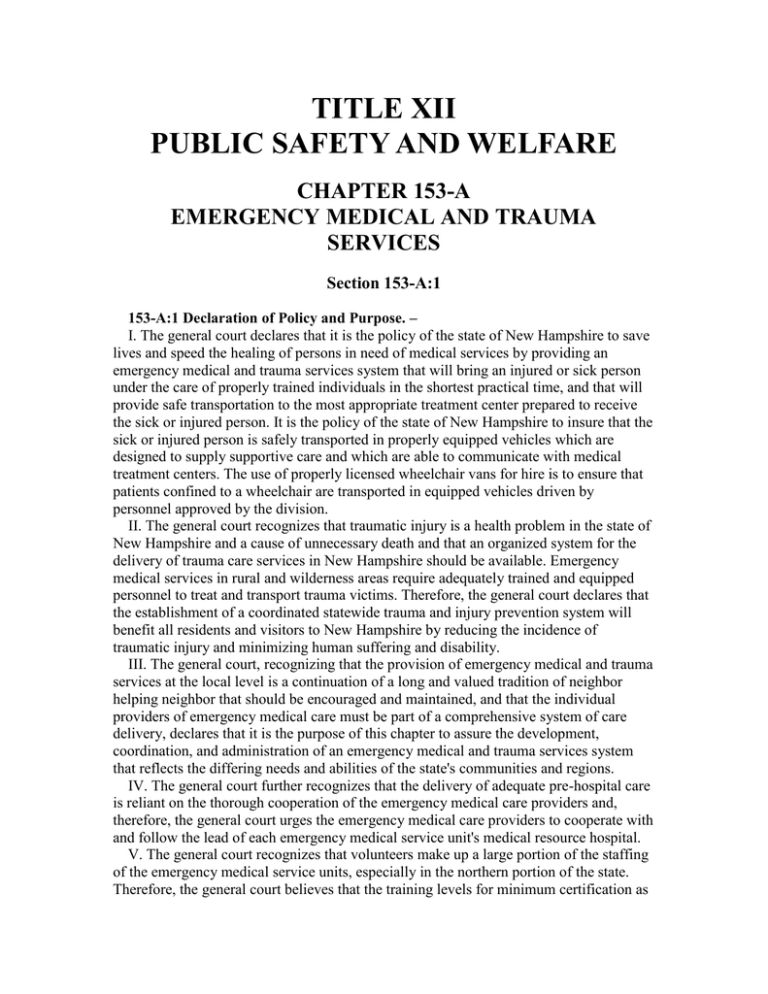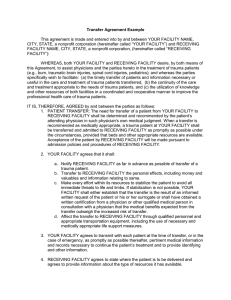N.H. Rev. Stat. §153-A-1 et seq.doc
advertisement

TITLE XII PUBLIC SAFETY AND WELFARE CHAPTER 153-A EMERGENCY MEDICAL AND TRAUMA SERVICES Section 153-A:1 153-A:1 Declaration of Policy and Purpose. – I. The general court declares that it is the policy of the state of New Hampshire to save lives and speed the healing of persons in need of medical services by providing an emergency medical and trauma services system that will bring an injured or sick person under the care of properly trained individuals in the shortest practical time, and that will provide safe transportation to the most appropriate treatment center prepared to receive the sick or injured person. It is the policy of the state of New Hampshire to insure that the sick or injured person is safely transported in properly equipped vehicles which are designed to supply supportive care and which are able to communicate with medical treatment centers. The use of properly licensed wheelchair vans for hire is to ensure that patients confined to a wheelchair are transported in equipped vehicles driven by personnel approved by the division. II. The general court recognizes that traumatic injury is a health problem in the state of New Hampshire and a cause of unnecessary death and that an organized system for the delivery of trauma care services in New Hampshire should be available. Emergency medical services in rural and wilderness areas require adequately trained and equipped personnel to treat and transport trauma victims. Therefore, the general court declares that the establishment of a coordinated statewide trauma and injury prevention system will benefit all residents and visitors to New Hampshire by reducing the incidence of traumatic injury and minimizing human suffering and disability. III. The general court, recognizing that the provision of emergency medical and trauma services at the local level is a continuation of a long and valued tradition of neighbor helping neighbor that should be encouraged and maintained, and that the individual providers of emergency medical care must be part of a comprehensive system of care delivery, declares that it is the purpose of this chapter to assure the development, coordination, and administration of an emergency medical and trauma services system that reflects the differing needs and abilities of the state's communities and regions. IV. The general court further recognizes that the delivery of adequate pre-hospital care is reliant on the thorough cooperation of the emergency medical care providers and, therefore, the general court urges the emergency medical care providers to cooperate with and follow the lead of each emergency medical service unit's medical resource hospital. V. The general court recognizes that volunteers make up a large portion of the staffing of the emergency medical service units, especially in the northern portion of the state. Therefore, the general court believes that the training levels for minimum certification as an emergency medical care provider should continue to allow future volunteer emergency medical care provider participation. VI. The general court declares that, to the extent it is possible, it is the policy of the state of New Hampshire to allow patients to be transported to the hospital, medical facility, or location of their choice in their area, if there is no compelling medical reason to the contrary. Further, the general court declares that, if appropriate, durable power of attorney for health care and the living will statutes should be taken into consideration in providing emergency medical and trauma services. Source. 1999, 345:6, eff. July 1, 1999. TITLE XII PUBLIC SAFETY AND WELFARE CHAPTER 153-A EMERGENCY MEDICAL AND TRAUMA SERVICES Section 153-A:2 153-A:2 Definitions. – In this chapter: I. "Coordinating board'' means the emergency medical and trauma services coordinating board established in RSA 153-A:3. II. "Commissioner'' means the commissioner of the department of safety. III. "Director'' means the director of the division of emergency medical services, department of safety. IV. "Division'' means the division of emergency medical services, department of safety. V. "Emergency medical care provider'' means an employee or volunteer member of a public or private organization having responsibility for the delivery of health services to individuals experiencing illness or injury at a location other than a hospital or other medical facility. The term shall not include lifeguards at swimming facilities or members of ski patrols, unless said individuals are performing invasive patient care procedures. VI. "Emergency medical services'' means the pre-hospital assessment and treatment of a sick or injured individual initiated at the scene of an incident and continued through the transport and transfer, if found appropriate, of the individual to a medical facility or other appropriate location in order to prevent loss of life or aggravation of physiological or psychological illness or injury. VII. "Emergency medical services instructor/coordinator'' means a person who has completed the requirements of an instructor training program under RSA 153-A:20, VIII. VIII. "Emergency medical services training agency'' means an organization, public or private, which assumes the responsibility for providing emergency medical services education and which has completed the requirements of an agency training program which meets the requirements of rules adopted under RSA 153-A:20, VIII. IX. "Emergency medical service unit'' means an organization, public or private, operating alone or as part of a larger organization, which has the responsibility to provide emergency medical services. The term shall not include ski patrols unless a ski patrol is providing invasive patient care procedures. X. "Emergency medical service vehicle'' means a land, air, or water vehicle designed, equipped, and used for the transport of sick or injured individuals. XI. "Facility'' means a hospital as defined in RSA 151-C:2, XX. XII. "Local option'' means a protocol for which a medical resource hospital and the local medical control physician have complete authority and jurisdiction, including training, implementation, and quality assurance. A local option may be more restrictive but shall not be less restrictive than the minimum state standard protocols approved and issued by the emergency medical services medical control board. XIII. "Mass casualty incident'' means any emergency event that cannot be resolved through the use of the emergency resources that are available locally on a regular daily basis. XIV. "Emergency medical services medical control board'' means the board established in RSA 153-A:5. XV. "Medical control'' means medical supervision and medical accountability for emergency medical care and includes direction and advice from a physician provided through: (a) "Off-line'' medical control which includes education, protocol development, critique, leadership, advice, and quality control. (b) "On-line'' medical control which exists when pre-hospital providers communicate directly with a physician or the physician designee at a receiving or medical resource hospital. Such direction may be based on the personal preference of the specific on-line physician, but more ideally it is based on protocols for the management of specific problems. This physician assumes responsibility and gives orders for individual patient''s care. XVI. "Patient'' means an individual who, as a result of illness or injury, needs immediate medical attention, whose physical or mental condition is such that the individual is in imminent danger of loss of life or significant health impairment, or who may otherwise be incapacitated as a result of a physical or mental condition. XVII. "Protocol'' means a written description of a patient care process specifying the circumstances under which emergency medical care providers may function under their own licenses or through medical control. Protocols are approved and issued by the emergency medical services medical control board. XVIII. "Public agency'' means the state or any of its political subdivisions, which provide police, firefighting, emergency medical, ambulance, or other emergency services. XIX. "Response expense'' means reasonable costs incurred by a public agency in making an appropriate response to an incident. This definition shall include, but not be limited to, the costs of police, firefighters, and rescue and emergency medical services, including the salaries of such persons. XX. "Trauma hospital'' means an acute care hospital licensed under RSA 151 to operate as a hospital and classified by the department according to the level of trauma care it is capable of providing. XXI. "Trauma patient'' means a person who has sustained a physical injury that may require immediate medical and surgical intervention to preserve life or prevent permanent disability. XXII. "Trauma system'' means the organized, managed, and rapid delivery of appropriate pre-hospital, hospital, and rehabilitative care to the injured person whose injury may require the services of trauma care specialized personnel and facilities to ensure an optimal outcome. Source. 1999, 345:6, eff. July 1, 1999.


